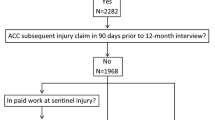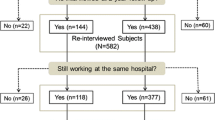Abstract
Purpose Understanding individual factors associated with return to work (RTW) post-injury is an important goal of compensation systems research. The aim of the present study was to determine factors associated with time to return to work following acute unintentional injuries. Methods A prospective cohort study was conducted in Victoria, Australia. The cohort comprised 133 persons who were employed at the time they were admitted to one of three study hospitals. Baseline health status data was obtained retrospectively at one-week post-injury and participants were further surveyed at 1, 6, 12, 26 and 52 weeks post-injury to measure recovery. Multivariate Cox proportional hazards regression analysis was used to examine the association between potential prognostic factors and time to RTW during the 12 month study. Results At the end of 12 months follow-up, 81.2% of the study cohort had returned to work. Older age, increased injury severity, self reported symptomatic pain and poor mental health at 1 week post-injury were associated with extended time to RTW. A significant statistical interaction between the receipt of compensation and high social functioning as measured by the SF-36 or strong social relationships as measured by the Assessment of Quality of Life was associated with earlier RTW. Participants reporting strong social relationships and high social functioning at 1 week post-injury and entitled to injury compensation returned to work 2.05 and 3.66 times earlier respectively, than similar participants with no entitlement to compensation. Conclusions Both injury-related and psychosocial factors were associated with the duration of time to RTW following acute unintentional injuries. This study replicated previously reported findings on social functioning and compensation from an independent acute trauma sample. Programs or policies to improve social functioning early post-injury may provide opportunities to improve the duration of time to RTW following injury.

Similar content being viewed by others
References
Urquhart DM, Williamson OD, Gabbe BJ, Cicuttini FM, Cameron PA, Richardson MD. Outcomes of patients with orthopaedic trauma admitted to level 1 trauma centres. ANZ J Surg. 2006;76:600–6.
Access Economics. The economic costs of spinal cord injury and traumatic brain injury in Australia; Transport Accident Commission, 2009.
Williamson OD, Gabbe BJ, Cameron PA, Edwards ER, Richardson MD. Predictors of moderate or severe pain 6 months after orthopaedic injury: a prospective cohort study. J Orthop Trauma. 2009;23:139–44.
Fitzharris M, Bowman D, Ludlow K. Factors associated with return-to-work and health outcomes among survivors of road crashes in Victoria. Aust NZ J Public Health. 2009;34:153–60.
Ebel BE, Mack C, Diehr P, Rivara FP. Lost working days, productivity, and restraint use among occupants of motor vehicles that crashed in the United States. Inj Prev. 2004;10:314–9.
Clay FJ, Newstead SV, Watson WL, Ozanne-Smith J, McClure RJ. Bio-psychosocial determinants of time lost from work following non life threatening acute orthopaedic trauma. BMC Musculoskelet Disord. 2010;11:6.
Oleinick A, Gluck JV, Guire K. Factors affecting first return to work following a compensable occupational back injury. Am J Ind Med. 1996;30:540–55.
Gabbe BJ, Cameron PA, Williamson OD, Edwards ER, Graves SE, Richardson MD. The relationship between compensable status and long-term patient outcomes following orthopaedic trauma. Med J Aust. 2007;187:14–7.
Dunstan DA, Covic T. Compensable work disability management: a literature review of biopsychosocial perspectives. Aust Occup Ther. 2006;53:67–77.
Evans T. Work: a self affirming experience. New Paradigm. 2002.
Strazdins L, D’Souza RM, Lim LL, Broom DH, Rodgers B. Job strain, job insecurity, and health: rethinking the relationship. J Occup Health Psychol. 2004;9:296–305.
Harrison K, Allen S. Features of occupational rehabilitation systems in Australia: a map through the maze. Work. 2003;21:141–52.
Clay FJ, Newstead SV, McClure RJ. A systematic review of early prognostic factors for return to work following acute orthopaedic trauma. Injury. 2010;41:787–803.
Hou W-H, Tsauo J-Y, Lin C-H, Liang H-W, Du C-L. Worker’s compensation and return-to-work following orthopaedic injury to extremities. J Rehabil Med. 2008;40:440–5.
Soberg HL, Finset A, Bautz-Holter E, Sandvik L, Roise O. Return to work after severe multiple injuries: a multidimensional approach on status 1 and 2 years postinjury. J Trauma. 2007;62:471–81.
MacKenzie EJ, Bosse MJ, Kellam JF, Pollak AN, Webb LX, Swiontkowski MF, et al. Early predictors of long-term work disability after major limb trauma. J Trauma. 2006;61:688–94.
Watson WL. Of life and limb: measuring the burden of nonfatal injury. PhD Thesis, Monash University, 2005.
Watson WL, Ozanne-Smith J, Richardson J. Retrospective baseline measurement of self-reported health status and health-related quality of life versus population norms in the evaluation of post-injury losses. Inj Prev. 2007;13:45–50.
Department Human Services: The Victorian Admitted Episode Database: An Overview, vol. 14. Melbourne: Acute Health Division, Department of Human Services, 2004.
Osler T, Baker SP, Long W. A modification of the injury severity score that both improves accuracy and simplifies scoring. J Trauma. 1997;43:922–5.
Brenneman FD, Boulanger BR, McLellan BA, Redelmeier DA. Measuring injury severity: time for a change? J Trauma. 1998;44:580–2.
Ware Jr J, Snow K, Kosinski M, Gandek B. SF-36 health survey: manual and interpretation guide. Boston: The Health Institute, New England Medical Center; 1993.
Ware JE Jr. SF-36 health survey update. Spine. 2000;25:3130–9.
Kopjar B. The SF-36 health survey: a valid measure of changes in health status after injury. Inj Prev. 1996;2:135–9.
Bowling A. Measuring health: a review of quality of life measurement scales. Buckingham: Open University Press; 1997.
Hawthorne G, Richardson J, Osborne R. The Assessment of Quality of Life (AQoL) instrument: a psychometric measure of health-related quality of life. Qual Life Res. 1999;8:209–24.
Wlodarczyk JH, Brodaty H, Hawthorne G. The relationship between quality of life, mini-mental state examination, and the instrumental activities of daily living in patients with Alzheimer’s disease. Arch Gerontol Geriatr. 2004;39:25–33.
Hawthorne G, Richardson J, Day NA. A comparison of the Assessment of Quality of Life (AQoL) with four other generic utility instruments. Ann of Med. 2001;33:358–70.
Hebert JS, Ashworth NL. Predictors of return to work following traumatic work-related lower extremity amputation. Disabil Rehabil. 2006;28:613–8.
Buitenhuis J, de Jong PJ, Jaspers JPC, Groothoff JW. Work disability after whiplash: a prospective cohort study. Spine. 2009;34:262–7.
Desbiens NA, Wu AW, Alzola C, Mueller-Rizner N, Wenger NS, Connors AF Jr, et al. Pain during hospitalization is associated with continued pain six months later in survivors of serious illness. Am J Ind Med. 1997;102:269–76.
Castillo RC, MacKenzie EJ, Wegener ST, Bosse MJ. Prevalence of chronic pain seven years following limb threatening lower extremity trauma. Pain. 2006;124:321–9.
Du CL, Lai CF, Wang JD. Delayed return-to-work in workers after non-severe occupational upper extremity fracture in Taiwan. J Formos Med Assoc. 2007;106:887–93.
Seland K, Cherry N, Beach J. A study of factors influencing return to work after wrist or ankle fractures. Am J Ind Med. 2006;49:197–203.
Wong JYP. Time off work in hand injury patients. J Hand Surg. 2008;33:718–25.
Temkin NR, Corrigan JD, Dikmen SS, Machamer J. Social functioning after traumatic brain injury. J Head Trauma Rehabil. 2009;24:460–7.
Lucke KT, Coccia H, Goode JS, Lucke JF. Quality of life in spinal cord injured individuals and their caregivers during the initial 6 months following rehabilitation. Qual Life Res. 2004;13:97–110.
Lund ML, Nordlund A, Bernspang B, Lexell J. Perceived participation and problems in participation are determinants of life satisfaction in people with spinal cord injury. Disabil Rehabil. 2007;29:1417–22.
Corry N, Pruzinsky T, Rumsey N. Quality of life and psychosocial adjustment to burn injury: social functioning, body image, and health policy perspectives. Int Rev Psychiatry. 2009;2:539–48.
Brouwer S, Reneman MF, Bültmann U, van der Klink JJ, Groothoff JW. A prospective study of return to work across health conditions: perceived work attitude, self-efficacy and perceived social support. J Occup Rehabil. 2010;20:104–12.
Lysaght RM, Larmour-Trode S. An exploration of social support as a factor in the return-to-work process. Work. 2008;30:255–66.
Watson WL, Ozanne-Smith J, Richardson J. An evaluation of the AQoL utility instrument as a measure of the impact of injury on health-related quality of life. Int J Inj Contr Saf Promot. 2005;12:227–39.
Struchen MA, Davis LC, Bogaards JA, Hudler-Hull T, Clark AN, Mazzei DM. Making connections after brain injury: development and evaluation of a social peer-mentoring program for persons with traumatic brain injury. J Head Trauma Rehabil. 2011;26:4–19.
Acknowledgments
The authors wish to acknowledge the statistical advice provided by Dr Janneke Berecki-Gisolf. The authors wish to thank the study hospitals for facilitating the opportunity to recruit patients and gratefully acknowledge the study participants. The Monash University Accident Research Centre Postgraduate Students Fund provided funding for the data collection phase of this study. The funding body played no role in the design, conduct, analysis or interpretation of the data or in the writing of this article. WW was the recipient of a Monash University Accident Research Foundation John Lane PhD Scholarship at the time of the data collection. All authors currently receive funding from a grant by WorkSafe Victoria and Transport Accident Commission. All authors are independent from their funders.
Conflict of Interest
All authors of this manuscript declare no competing interests.
Author information
Authors and Affiliations
Corresponding author
Rights and permissions
About this article
Cite this article
Clay, F.J., Fitzharris, M., Kerr, E. et al. The Association of Social Functioning, Social Relationships and the Receipt of Compensation with Time to Return to Work Following Unintentional Injuries to Victorian Workers. J Occup Rehabil 22, 363–375 (2012). https://doi.org/10.1007/s10926-012-9354-4
Published:
Issue Date:
DOI: https://doi.org/10.1007/s10926-012-9354-4




